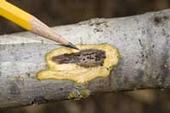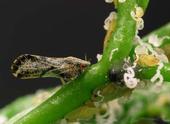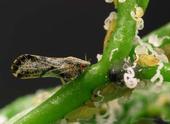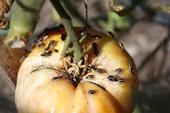- Author: Karey Windbiel-Rojas

As you plan the last few camping trips of the summer, remember: buy firewood when you get to your destination. Don't move firewood! Buy it where you burn it.
Why?
Simply, we don't want wood-boring pests and diseases to be moved from one area in the state to another area where they don't exist. Buy wood where you intend to burn it and don't bring any wood home with you upon your return.
Several beetles that bore into trees such as the gold-spotted oak borer, polyphagus shothole borer, walnut twig beetle, and others may be present in the wood you gather or buy in your area. If you buy or gather wood and then take it with you to another...
- Author: Karey Windbiel-Rojas

Did you know that this week (June 6 - June 14) is California Invasive Species Action week? The goal of this week is to increase public awareness of invasive species issues and share ways we can all participate in the fight against California's invasive species and their impacts on our environment and natural resources.
Find out more about California Invasive Species Action week, species of concern, schedule of events, and what you can do to help prevent invasive species at https://www.wildlife.ca.gov/Conservation/Invasives/Action-Week.
The University of...
- Author: Elizabeth E Grafton-Cardwell
- Author: Cheryl A. Wilen

[From the December 2014 issue of the UC IPM Green Bulletin]
In August 2012, we wrote about the Asian citrus psyllid (ACP) in UC IPM's Green Bulletin newsletter. At that time, ACP was found only in San Diego, Imperial, Riverside, San Bernardino, Los Angeles, and Orange counties. It has since been detected in Ventura, Santa Barbara, San Luis Obispo, Fresno, Kern, and Tulare counties, and in the last three months has been found in San Joaquin and Santa Clara counties (Figure...
![Brownish adult, yellow nymphs, and white wax of Asian citrus psyllids, Diaphorina citri Kuwayama. [Photo by Michael E. Rogers, University of Florida]](https://ucanr.edu/blogs/UCIPMurbanpests/blogfiles/25390small.jpg)
Every year, California receives, on average, six new exotic invasive pests of concern; that's about one new pest every 60 days. These may be plants, insects or other arthropods, mollusks, plant pathogens such as fungi and bacteria, vertebrates, or any other organism not native to our state and with the capacity to negatively impact agriculture, urban environments and/or natural ecosystems. These invasive pests enter California on plant material and other biological substrates, as hitchhikers on trade goods and in ship ballast water, and sometimes even because of smuggling operations. Without the natural enemies that kept them in check in their native lands, they are free to reproduce and wreak havoc. Such pest invasions may then lead to...
- Author: Surendra Dara
- Editor: Karey Windbiel-Rojas

The Bagrada bug (Bagrada hilaris) is an invasive stink bug insect that was first reported in 2008 in Los Angeles County, California. It has now spread to several counties in California and is moving northward in the state. Bagrada bug is also spreading eastwards from California and is currently reported in Nevada, Arizona, Utah, New Mexico, and Texas.
Distribution: Citizen scientists have been instrumental in reporting the occurrence of Bagrada in various counties and are helping map its current distribution. As of September 2014, Bagrada bug is known to be present in Imperial, San Diego, Orange, Riverside, Los Angeles, San Bernardino, Kern, Kings, Inyo, Fresno, Merced,...


